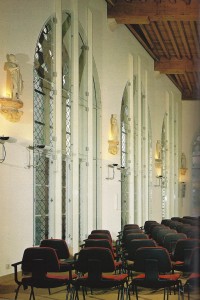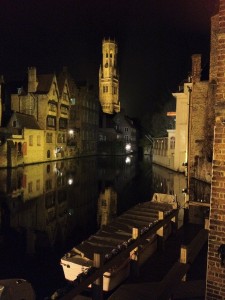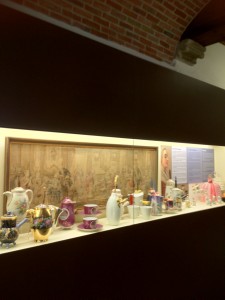
The top floor of the Friet Museum in Bruges, Belgium - a combination of history, whimsy and fairy tale.
I just returned from a two week vacation in Europe with my sister, where I was reminded how innovative and creative Europeans are with their historic buildings. Our travels took us to Amsterdam, Bruges and Paris, cities neither of us had been to before. We visited the major museums and monuments in each city of course, but it was two reuse projects in Bruges that intrigued me the most from a sustainability point of view. Okay they just happened to also house museums to two of my favorite food groups – French Fries and Chocolate!
In Bruges
Bruges, which is in northwest Belgium, is often called the “Venice of the North”, for the canals that weave through the city and the medieval buildings, which line the canals and streets. It is a magical, fairy tale city filled with buildings that are centuries if not millennia old. The ironic thing about Bruges is that knowledge of it seems to have been created by two almost self-deprecatory stories centered in Bruges: a late 19th century novella by Belgian poet Georges Rodenbach, Bruges-la-Morte and the 2008 film starring Ralph Fiennes, Colin Farrell and Brendan Gleeson, In Bruges. Rodenbach’s novella, which used the “decaying” landscape of Bruges as the centerpiece for a story about a grief-stricken man who moves to Bruges to be closer to his deceased wife, was at first criticized by Belgians but ended up spurring somewhat of a cult and a travel frenzy which is sometimes credited with reviving Bruges. The book itself included photographs of Bruges with the city presented as a character in the story. Bruges is now the number one tourist destination in Belgium and has been for quite some time.
The movie, In Bruges, tells the story of two hit men sent by their boss from London to Bruges for 2 weeks to hide after a sloppy “hit”. The older, more experienced hit man is enchanted with the buildings of Bruges and spends his time sightseeing, while the younger, played by Colin Farrell, laments that Bruges is a nightmare for idiots. Everyone we met asked us if we had seen “In Bruges” and seemed delighted by the movie. Our taxi driver was thrilled to tell us that he was Colin Farrell’s driver. It was with this background, and little more, that we chose to visit Bruges on this trip. Having seen In Bruges prior to our trip, and reading the book while traveling, I was anticipating a museum-like city filled with medieval references. And while it is a city filled with museums, its activity and the kindness and generosity of the inhabitants, made it our favorite stop on this trip. I often say that I prefer a Rome over a Florence, because of the layers, so anticipated that Bruges would be like a Florence. Instead, I found many layers, both physical and historical, throughout the city. Many of the buildings have been reused again and again over hundreds of years, with alterations yes, but in many cases, alterations that speak of the current time with a very respectful reference to past uses. This is what I love about Europe and its approach to preservation. And this is why it’s such an inherently sustainable place, at least in the core cities. These are the places that we all try to emulate and design.
From Genoese Lodge to French Fries (or Frites)

The top floor of the Genoese Lodge Building worked well as the conference room for the 1978 bank conversion. (See the top photo for its current use.)
I will admit, I was obsessed with visiting the Frites Museum, because I thought it was so unusual. I didn’t think much about what the building would be like, until we approached the entrance and I was stunned by the Gothic façade of white Brabant sandstone and lancet windows. The museum itself is both a methodical study of the history of potatoes leading to the Belgium Fry, and a whimsical representation of a food type that is known worldwide as the French Fry. The tour finishes at the café in the basement with an excellent version of the French fry (or rather, the Belgian fry!).
The earliest part of the building was built in 1399 as the headquarters for the Genoese businessmen and tradespeople in Bruges. City tour guides like to say that the Genoese Lodge is the “oldest monument in Bruges with a date on it.” By 1575 the building had been taken over by the serge weavers and after centuries of different uses, some alterations and additions, a bank restored and renovated it in 1978. Enter the founder of the Chocolate Museum, who bought and renovated the property two decades later, opening it as the Frietmuseum in April 2010. Many of the changes made to the building by the earlier bank worked well for the museum – including the cafeteria in the basement, and the modern staircases.
Aztecs, Chocolate and Wine
While the Frietmuseum was first on my list, the Chocolate Museum was right behind. Upon visiting the Frietmuseum, we discovered that the Chocolate Museum was its sister museum, opened by the same man several years earlier and just a few blocks away. The Maison de Croon dates from around 1480 and was built as a wine tavern. It was later used by patissiers and tart makers and in the 20th century, it was variously used as the headquarters of the employment exchange, the police training school, Crédit Communal de Belgique and VDAB (the Flemish Employment Bureau). The Bruges Chocolate Museum was opened by Eddy Van Belle, the president of Puratos Group, on March 20th, 2004 in Bruges, Belgium, followed by branch museums in Prague and Paris.
Like the French Fry story, the “Choco-story” started with the history of chocolate and the Aztecs, leading to the history of Belgium’s leadership in the world of chocolate. I liked the layout of the Frietmuseum a bit better, it was a little more spacious, but both buildings respectfully added exhibitry and furnishings to the historic buildings, reactivating them and using the original character defining features as features in the new tales
Who’s Behind This?
What I found very interesting is that both museums are private museums started by one man, Eddy Van Belle, president of Puratos Group, a worldwide leader in the food services industry. Both museums are well done, not very profound, interpretations of their topics. Just enough history to make it informative, and just enough respect for the historic buildings to remind visitors of why Bruges is so special. I found both buildings and museums a fresh and even groovy way to revive history and make it relevant. And French fries and chocolate tastings didn’t hurt either!
And if you’d like to “subscribe” or follow this blog, True Green Cities, please sign up through the “Subscribe” button at the bottom right of this page. Press “email” and enter your email – you’ll receive a daily recap when new blogs are posted.


